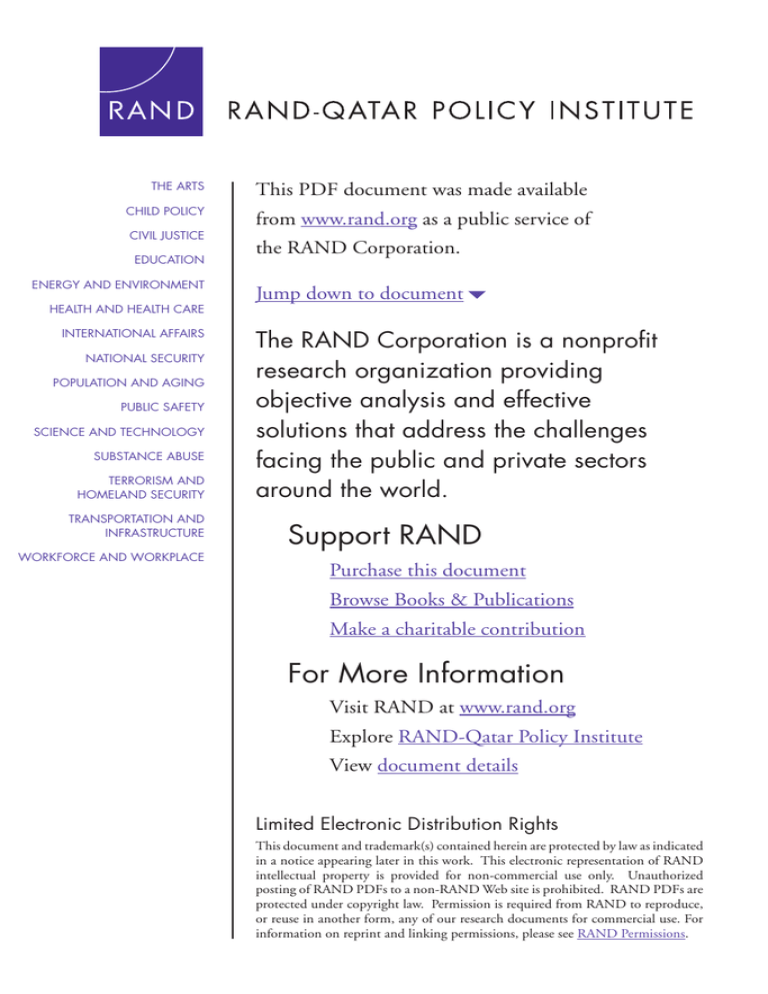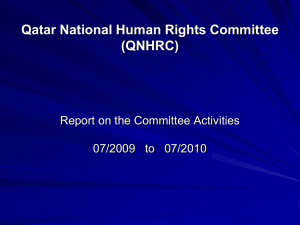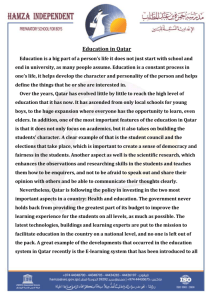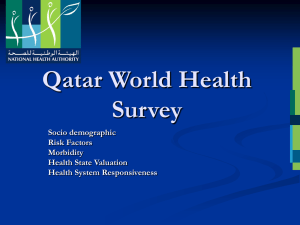
THE ARTS
This PDF document was made available
CHILD POLICY
from www.rand.org as a public service of
CIVIL JUSTICE
EDUCATION
ENERGY AND ENVIRONMENT
HEALTH AND HEALTH CARE
INTERNATIONAL AFFAIRS
NATIONAL SECURITY
POPULATION AND AGING
PUBLIC SAFETY
SCIENCE AND TECHNOLOGY
SUBSTANCE ABUSE
TERRORISM AND
HOMELAND SECURITY
TRANSPORTATION AND
INFRASTRUCTURE
WORKFORCE AND WORKPLACE
the RAND Corporation.
Jump down to document6
The RAND Corporation is a nonprofit
research organization providing
objective analysis and effective
solutions that address the challenges
facing the public and private sectors
around the world.
Support RAND
Purchase this document
Browse Books & Publications
Make a charitable contribution
For More Information
Visit RAND at www.rand.org
Explore RAND-Qatar Policy Institute
View document details
Limited Electronic Distribution Rights
This document and trademark(s) contained herein are protected by law as indicated
in a notice appearing later in this work. This electronic representation of RAND
intellectual property is provided for non-commercial use only. Unauthorized
posting of RAND PDFs to a non-RAND Web site is prohibited. RAND PDFs are
protected under copyright law. Permission is required from RAND to reproduce,
or reuse in another form, any of our research documents for commercial use. For
information on reprint and linking permissions, please see RAND Permissions.
This product is part of the RAND Corporation monograph series.
RAND monographs present major research findings that address the
challenges facing the public and private sectors. All RAND monographs undergo rigorous peer review to ensure high standards for
research quality and objectivity.
Post-Secondary
Education
Qatar
in
Cathleen Stasz Eric R. Eide Francisco Martorell
•
•
with
Louay Constant Charles A. Goldman Joy S. Moini
Vazha Nadareishvili Hanine Salem
•
•
•
Prepared for the Supreme Education Council
The research described in this report was prepared for the Supreme
Education Council and conducted within RAND Education and the
RAND-Qatar Policy Institute, programs of the RAND Corporation.
Library of Congress Cataloging-in-Publication Data
Postsecondary education in Qatar : employer demand, student choice, and options for
policy / Cathleen Stasz ... [et al.].
p. cm.
Includes bibliographical references.
ISBN 978-0-8330-4173-9 (pbk.)
1. Education, Higher—Qatar. 2. Higher education and state—Qatar.
I. Stasz, Cathleen, 1947–
LA1435.P67 2007
378.5363—dc22
2007017402
The RAND Corporation is a nonprofit research organization providing
objective analysis and effective solutions that address the challenges
facing the public and private sectors around the world. R AND’s
publications do not necessarily reflect the opinions of its research clients
and sponsors.
R® is a registered trademark.
Cover design by Peter Soriano
Cover photo: Copyright Martin Belam (currybet.net). Used with permission.
© Copyright 2007 RAND Corporation
All rights reserved. No part of this book may be reproduced in any
form by any electronic or mechanical means (including photocopying,
recording, or information storage and retrieval) without permission in
writing from RAND.
Published 2007 by the RAND Corporation
1776 Main Street, P.O. Box 2138, Santa Monica, CA 90407-2138
1200 South Hayes Street, Arlington, VA 22202-5050
4570 Fifth Avenue, Suite 600, Pittsburgh, PA 15213-2665
RAND URL: http://www.rand.org
To order RAND documents or to obtain additional information, contact
Distribution Services: Telephone: (310) 451-7002;
Fax: (310) 451-6915; Email: order@rand.org
Summary
Like the government of many other countries, Qatar’s government
views education as a crucial element in the nation’s economic, social,
and political development. Qatar has embarked on reforms at all levels
of its education system, the goal being to develop the human capital of
Qatari nationals and to ensure that Qatar’s citizens can contribute fully
to society, both economically and socially.
Progress is being made, but Qatar still faces a number of challenges. The education system for kindergarten through grade 12 (K–
12) does not adequately prepare Qataris for work or post-secondary
study, and current reforms to the K–12 system will take time to bear
fruit. The Qatari population is small, and the country depends on a
large expatriate workforce for both low- and high-skilled labor. Few
Qataris have the training or qualifications needed for high-demand,
high-skill jobs. Employment practices, which are linked to the social
welfare system, provide Qataris, especially men, with secure, wellcompensated jobs in the government sector: Nearly 77 percent of
employed Qataris work in the government or government enterprise
sectors. And Qatari women, who are more highly educated than
Qatari men, are less likely to pursue career employment and have limited employment opportunities because of cultural tradition.
Qatar has used its wealth to improve post-secondary educational
opportunities—for example, by establishing a number of world-class
institutions in Doha’s Education City. But these efforts to enhance the
quality of education have not undergone a broad strategic review. As a
xiii
xiv
Post-Secondary Education in Qatar
result, the extent to which available post-secondary educational offerings can meet Qatar’s current and future demands remains uncertain.
Qatar’s Supreme Education Council (SEC) asked RAND Education to analyze the current situation and to help articulate priorities for developing post-secondary educational opportunities, either in
Qatar or through financed study abroad. The resulting one-year study
addressed several questions:
1. In which occupations can Qataris make the greatest contribution to the society and economy, and what education and training are needed to realize these contributions?
2. What measures might encourage more Qataris, especially young
men, to pursue post-secondary education?
3. To what extent do existing institutions meet education and training needs? Are new investments required, and if so, where?
4. What are the benefits and costs of establishing local postsecondary institutions at the undergraduate and graduate levels
versus sending students abroad for these studies?
Data and Methods
We used a combination of qualitative and quantitative research methods for the study. To address issues of occupation and skill demand, our
research team reviewed secondary data and research from Qatar’s Planning Council, formally interviewed key employers in Qatar, and informally discussed relevant issues with other education stakeholders.
The study team also inventoried the post-secondary educational
offerings in Qatar, including private training organizations, and
obtained data on Qatar’s scholarship programs, which support highachieving students studying in Qatar and abroad.
Many decisionmakers in Qatar recognize that the education and
employment choices made by Qataris are often not well aligned with
Qatar’s new national priorities and initiatives, but evidence for why
these choices are made has been mostly anecdotal. To shed light on the
factors influencing education and employment choices, we used two
Summary
xv
surveys to gather systematic data that allowed us to generalize: a telephone survey of 99 Qataris who had graduated from secondary school
in 1998, and a survey administered to 260 students who were secondary school seniors in 2006. The survey of the 1998 graduates provided
a look at the transition to post-secondary education and employment in
the eight years following graduation from secondary school; the survey
of the 2006 seniors provided information on education and employment aspirations and the factors influencing those aspirations.
Findings
Demands for Education and Employment
Our employer interviews and data from Qatar’s Planning Council
indicate that demands for men are in the professional, technical, and
sales and service occupations and that women are more likely to find
employment in clerical jobs and in professional jobs within the government. Overall, the pattern of occupational demand favors individuals
with some post-secondary education supplemented with more-specific
job training.
Survey data from our study align with Qatar’s 2004 census data in
indicating that patterns of education and employment among Qataris
are somewhat misaligned with demand. This is especially true for
males: Qatari men continue to pursue careers in fields other than those
in demand—most notably the military and police—and a majority of
the male students surveyed aspire to these professions. As for Qatari
females, a high proportion are in the teaching profession, about 15 percent of the Qatari women surveyed hold professional jobs, and a high
proportion of the female students surveyed aspire to be managers or
professionals rather than teachers. Women’s opportunities appear to be
expanding, but cultural expectations may still work against women’s
employment in some fields.
The trend for Qatari females to pursue and achieve a postsecondary education in greater proportions than Qatari men will
likely continue given that twice as many female students as male stu-
xvi
Post-Secondary Education in Qatar
dents indicated that they plan to attend a university or obtain a postsecondary diploma.
While government policy aims to increase Qataris’ employment in the growing private sector, the trend for Qataris to work for
or seek work in the government or government enterprises will likely
continue.
Employers showed a high demand for people skilled in certain
areas, especially English, information and communication technology
(ICT), and business. They also value the so-called soft skills, such as a
good work attitude and a willingness to learn. By and large, employers indicated dissatisfaction with the skills of secondary school and
university graduates; they also pointed out several shortcomings of
Qataris compared with expatriate workers with respect to attitudes
toward work.
We found that many factors influence education and employment choices and aspirations, and that these factors often vary for
males versus females and for older versus younger people. For example,
in making post-secondary education and career choices, students are
highly influenced by parents and religious beliefs. While our findings
about these factors are in no way conclusive, they do provide important
insights for policymakers.
Qataris Who Do Not Pursue Post-Secondary Study
Even though economic demands in Qatar favor individuals with postsecondary education and training, a majority of Qataris do not pursue
post-secondary studies. What might induce more Qataris, especially
Qatari males, to do so? To isolate factors that might underlie the decision to pursue an education at the post-secondary level, we used census
data and data from our surveys to compare the characteristics and
experiences of Qataris who had decided to pursue a post-secondary
education with those of Qataris who had decided not to.
Our survey results highlight several factors involved in this complex decision. These findings are somewhat speculative, however,
because the sample sizes in some of the comparisons were small. With
this caveat, we can state that the most common reasons for not pursuing a post-secondary education are ineligibility for a scholarship and
Summary
xvii
family responsibilities. Because scholarships are attached to grades in
Qatar, what this effectively means is that a student’s poor performance
in secondary school is a significant barrier to further study. For these
individuals, opportunities for remedial education may have appeal
and may be of benefit for bringing more students into post-secondary
education.
Workers without a post-secondary education viewed additional
training in English and, to a lesser extent, basic computer skills as helpful for either advancing in their current job or getting a better job
in the future. These views align with the skill demands indicated by
employers.
Secondary school seniors who do not plan to pursue postsecondary studies are more likely to want to work in a government
ministry and less likely to go on to work in a government-owned or
privately owned company than are those who intend to continue their
studies. This suggests that the availability of secure, prestigious, and
well-paying government jobs that do not require post-secondary schooling may act as a disincentive to pursuing further education, especially
for Qatari males. In this case, changes in educational opportunities
alone may not be sufficient for altering the patterns of those choosing
not to pursue post-secondary studies.
Adequacy of Post-Secondary Education and Training Offerings
Our analysis of the opportunities available in Qatar for postsecondary education in high-demand fields indicated that there are
numerous relevant offerings at the certificate/diploma level and
undergraduate-degree level. It also indicated that there are very few
offerings at the graduate level in any field. However, Qatar’s Higher
Education Institute offers numerous scholarship opportunities for students of different abilities who want to study abroad, where such offerings are available, and some of these scholarships target preparation for
high-demand occupations.
One part of our review identified a large number of organizations in Qatar that provide training, including training in specific
skills highly valued in the labor market, such as English and ICT. The
opportunities for this type of training thus seem plentiful, although
xviii
Post-Secondary Education in Qatar
our study did not attempt to assess the quality of the training being
offered.
We found that the post-secondary offerings in Qatar provide
good coverage of high-demand fields at some levels but that there were
notable gaps:
• Opportunities for students who need remedial academic course
work are limited.
• High-quality degree choices in Qatar are limited.
• Opportunities to study for a master’s degree are limited.
These gaps have different effects on men and women, on recent secondary school graduates and those who have been out of school awhile,
and on students considered and not considered highly able.
Options for Post-Secondary Investment and Our
Recommendations
For each gap in Qatar’s educational offerings, we outlined the conceptual costs and benefits of three post-secondary investment options of
interest to the SEC: (1) restructure programs at Qatar University, (2)
recruit new foreign institutions to Qatar, and (3) develop new government-sponsored programs of less than four years.
Based on our study, we recommend that Qatari leadership consider the following investments for the three gaps in its post-secondary
offerings:
• Gap: Limited opportunities for remedial course work prior to
university study
– Option: Establish a government-sponsored community college
Addressing this gap will benefit remedial and adult students.
• Gap: Limited four-year degree choices for high-achieving students
in Qatar beyond the Education City offerings
– Option: Recruit a top liberal arts college to Education City
– Option: Develop an honors program at Qatar University
Addressing this gap will benefit high-achieving students.
Summary
xix
• Gap: Lack of master’s degrees in career-related fields in Qatar
– Option: Expand offerings of current Education City campuses
to include master’s degrees in career-related fields
– Option: Restructure Qatar University programs to begin offering more master’s degrees in career-related fields
Addressing this gap will benefit high-achieving students.
We also recommend that a financial-aid program for adults
be developed to help finance their post-secondary education and
training.
Another recommendation is that Qatari decisionmakers not invest
in any of these areas without first prioritizing the post-secondary gaps
according to their importance to the economy and society. The issues
to consider here include the extent to which an option addresses areas
of national significance in terms of furthering Qatar’s economic and
social goals, the number and type of individuals who will benefit from
investment in an option, and the trade-offs between study in Qatar
and study abroad. For example, providing high-quality graduate training in Qatar will go a long way toward developing future leaders for the
country, particularly women.
In addition, we recommend that the SEC conduct further feasibility studies to determine in detail what is involved in investing in
the areas of highest priority. It will also be necessary to estimate the
demand for post-secondary education related to each option.
We further recommend that a national campaign be conducted to
raise awareness of the importance of higher education and the occupational areas that will aid economic development. This campaign should
be directed both at parents, because they have much influence over
their children’s education and career choices, and at adults that might
want to resume their schooling, upgrade their English or ICT skills, or
further educate themselves as a way to advance in their current job or
expand their employment opportunities.
In going forward with these recommendations, it is crucial that
a long-term, overarching strategy of investment be developed for postsecondary education in Qatar, one that coordinates the various educa-
xx
Post-Secondary Education in Qatar
tional institutions and considers related policy areas, especially those
of employment and labor. At present, Qataris continue to pursue traditional occupational pathways in government ministries despite the
availability of ample opportunities for post-secondary education and
training in high-demand occupations. While the factors that influence
people’s education and career choices are complex, it is clear that these
decisions are to some degree influenced by Qatar’s employment policies and customs—for example, the virtual guarantee that Qatari men
with no more than a secondary school education will find secure, wellpaying, and prestigious jobs in Qatar’s government ministries. Another
influencing factor may be the limited educational and employment
opportunities that exist for women. Any post-secondary investment
strategy needs to be framed within a larger context that takes these factors into consideration. Only in this way will policymakers be able to
understand the range of incentives likely to be influencing individual
choices and thus be able to make the best investments for future generations of Qataris.







